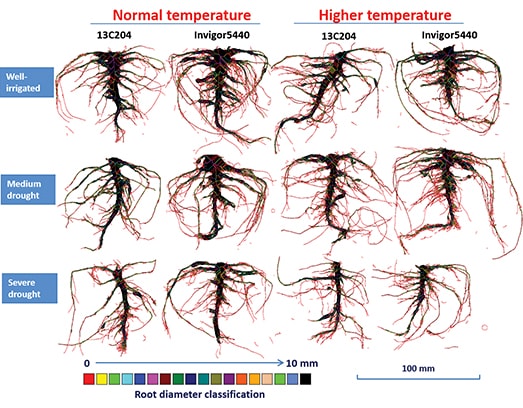Root ‘electricity’ measurement will help breed more resilient canola
Roots function as an early warning system for Brassica crops, detecting and responding to environmental stresses. Understanding root biology will help scientists and farmers create sturdier, stress-resistant crops. But root systems are complex, and difficult to study in a non-destructive manner.
Bao-Luo Ma’s team investigated the feasibility of measuring electrical properties of roots to investigate morphology (root surface area, length and volume) distribution and function. His team, over multiple studies, improved the feasibility of this promising, non-invasive strategy.

For the latest study, two canola genotypes were tested in controlled environments at AAFC Ottawa. Seedlings were sown in plastic pots containing dried greenhouse soil mix. After rearing crops in growth chambers for two weeks at 23/17 °C (day/night), researchers subjected them to varying temperature and water levels to simulate environmental stresses of heat and drought. After 15 days of treatment, the taproot and lateral roots were evaluated for their electrical properties (capacitance, resistance, impedance) and compared that to their root length, surface area and volume.
Key result: Electrical properties of Brassica roots accurately reflect root morphology and anchorage strength. This study refined the non-destructive method to breed Brassica lines that are more resistant to environmental stresses and have stronger root architecture to prevent root lodging.
Project title, Principal investigator: “Investigating tolerance of canola genotypes to heat and drought stresses, and root traits estimation by electrical capacitance,” Bao-Luo Ma, AAFC Ottawa
Funding: Growing Forward 2
Electrical measurements, they found, are a significant indicator of root morphology and anchorage strength. The current study adds to Ma’s earlier research, which showed that electrical measurements could potentially predict canola seed yield and seed quality. The work improves our understanding of root function under heat and drought stress and contributes to more effective genotype selection and improvement.
The current research’s non-invasive method gives scientists and canola breeders a simple, fast, and accurate way to better gauge root function, and then to harvest breeder seed from plants that have the desired traits. (A destructive test does not allow for this.)
A deeper understanding of root biology will help breeding programs select for crops that are heat- and drought-resistant and have more rigid root systems to decrease lodging risk under global warming. It will also help in agronomic improvements by contributing to sustainable canola production and maintain Canada’s food security in future climate change scenarios.
“Enhancing Rapeseed Tolerance to Heat and Drought Stresses in a Changing Climate: Perspectives for Stress Adaptation from Root System Architecture,” Wei Wu, Bao-Luo Ma, and Joann K. Whalen, Advances in Agronomy 2018
“Assessment of canola crop lodging under elevated temperatures for adaptation to climate change,” Wei Wu, and Bao-Luo Ma, Agricultural and Forest Meteorology 2018





